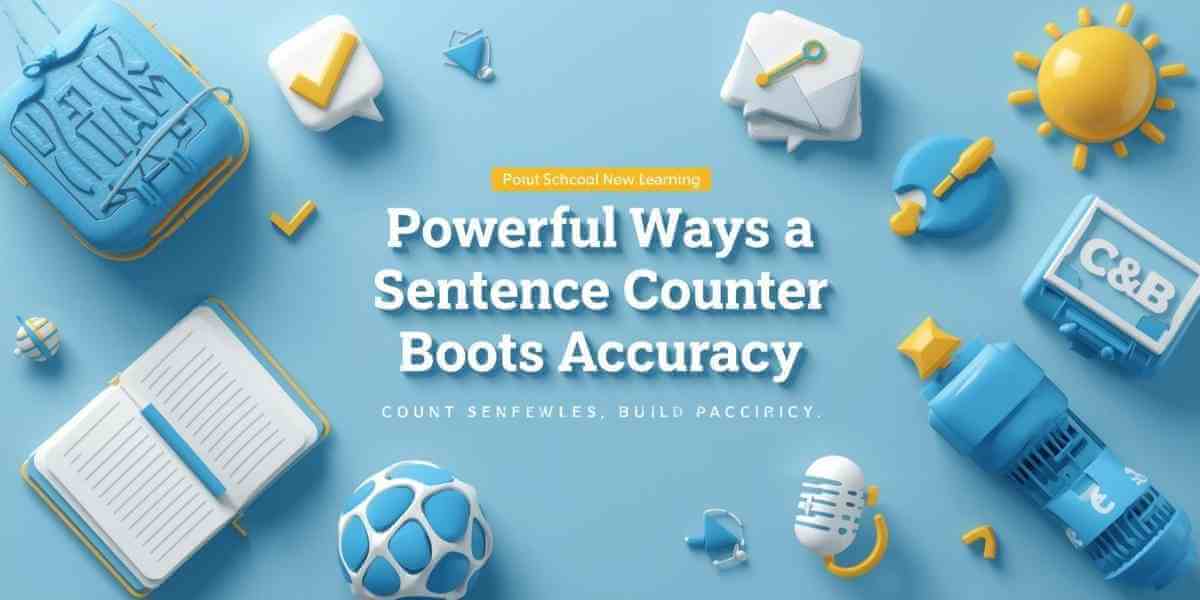Writing accurately is vital for both English learners and teachers. It reflects your command of the language, ensures clarity, and makes your work look professional. Whether you are writing essays, preparing lessons, or practicing, strong writing skills build confidence and credibility.
A simple yet powerful tool for improving accuracy is a sentence counter. It not only measures sentence length but also helps balance structure, avoid run-ons or fragments, and improve overall readability.
In this guide, we’ll explore ten effective ways a sentence counter can boost your writing accuracy. With examples, tips, and daily practice strategies, you’ll learn how to make your writing clearer, sharper, and more engaging – whether as a student or a teacher.
What is a Sentence Counter and Why Does It Matter
A sentence counter is a tool that counts the number of sentences in your text. Some advanced counters also measure words, characters, and even paragraphs. This helps writers see the structure of their content, ensuring it is concise and readable.
Benefits for Students
- Helps identify long, complex sentences that are hard to understand.
- Assists in breaking ideas into clear, simple sentences.
- Encourages better organization of essays and assignments.
Benefits for Teachers
- Allows teachers to quickly evaluate student writing.
- Supports teaching lessons on sentence structure and clarity.
- Saves time in grading by providing quick word and sentence analysis.
1. Improve Writing Accuracy with a Sentence Counter
Accuracy is about conveying ideas clearly without grammatical mistakes. A sentence counter helps spot overly long or run-on sentences, which are common errors among beginners.
Example of Run-on Correction
- Incorrect: I went to the store it was closed, so I returned home.
- Correct: I went to the store. It was closed, so I returned home.
Using this tool encourages writers to break down long sentences, making the text easier to read and understand.
2. Track Word Count Efficiently
Many students and writers struggle to meet word count requirements. A sentence counter often doubles as a word counter online. This makes it easy to check if you have reached the target word count for assignments or lessons.
Practical Tip
- Set a daily goal for writing practice (e.g., 300–500 words).
- Use a counter to monitor progress and avoid under- or overwriting.
3. Ensure Balanced Sentence Lengths
Writing that alternates between short and long sentences is more engaging. A sentence counter helps you analyze sentence lengths so your writing flows naturally.
Example
- Too short: I like books. I like pens. I like paper.
- Balanced: I like books, pens, and paper because they help me write and learn better.
Balancing sentences improves readability and keeps the audience interested.
4. Detect Overly Complex Sentences
Advanced writers sometimes create long sentences with multiple ideas, which can confuse readers. A sentence counter highlights sentences that may need simplification.
Practice Idea
- Identify sentences with more than 25 words.
- Break them into two or three simpler sentences.
- Check clarity with a teacher or peer.
This approach enhances writing precision and helps learners focus on one idea at a time.
5. Enhance Clarity and Readability
Clear writing is easier to understand. Using a sentence counter ensures that each sentence conveys a single idea effectively. Teachers can encourage students to revise sentences that are too long or unclear.
Example Activity
- Take a paragraph from your essay.
- Count the sentences and identify long ones.
- Rewrite them to improve readability.
6. Combine with a Character Counter Tool
Many online character counter tools integrate with sentence counters. This is useful for social media posts, summaries, or academic submissions that have character limits.
Why It Helps
- Prevents exceeding character limits in assignments.
- Encourages concise expression.
- Allows tracking both sentence and word count in one place.
By monitoring characters and sentences together, learners can improve both clarity and conciseness.
7. Track Progress in Writing Practice
Consistency is key to improvement. A sentence counter can track daily writing practice, helping learners notice improvements over time.
Daily Practice Tip
- Write a short paragraph every day.
- Use the counter to check the number of sentences.
- Gradually aim for more structured and well-organized sentences.
8. Avoid Common Writing Mistakes
Beginners often make mistakes like run-on sentences, missing punctuation, or overly long sentences. A sentence counter helps detect these errors before submitting or publishing content.
Common Mistakes to Watch
- Run-on sentences: Too many ideas in one sentence.
- Fragmented sentences: Incomplete thoughts that confuse readers.
- Overly long sentences: Hard to follow and reduces clarity.
By counting sentences regularly, learners can identify patterns in their mistakes and improve step by step.
9. Improve Lesson Planning for Teachers
Teachers preparing lessons can benefit from a sentence counter to design exercises for writing practice. By analyzing student submissions, teachers can:
- Assess sentence length and complexity.
- Identify students who need extra support with structure.
- Provide personalized tips for improving clarity.
This tool can also help teachers create example paragraphs for students to practice rewriting, combining grammar learning with practical exercises.
10. Enhance Digital Content and Online Writing
For students and teachers creating online content, a sentence counter ensures writing is concise and readable. When combined with a writing accuracy tool or a word counter online, it helps produce high-quality content for blogs, emails, or social media.
Example for Online Writing
- Without counter: I went to the library and I borrowed books. I also met my friend and we discussed the project, and then I returned home feeling tired.
- With counter: I went to the library and borrowed books. I met my friend and we discussed the project. Then I returned home feeling tired.
This simple revision improves clarity, structure, and readability.
Practical Tips for Using a Sentence Counter
Using a sentence counter effectively requires some practice. Here are tips to make the most of it:
- Set Writing Goals: Decide how many sentences or words you want per paragraph.
- Check Regularly: Use the counter after each paragraph to track structure.
- Combine with Other Tools: Use character counters or word counters online to track multiple metrics.
- Revise for Clarity: If a sentence is too long, break it down.
- Encourage Peer Review: Compare your sentence count with classmates to improve learning.
Advanced Benefits of Using a Sentence Counter
For students and teachers who practice writing regularly, a sentence counter offers more than just counting sentences – it helps improve the overall quality and structure of writing. Let’s explore some deeper benefits.
1. Developing Awareness of Writing Style
Every writer has a unique style. Some prefer short, simple sentences, while others write long, detailed ones. Using a sentence counter helps you understand which style dominates your writing.
- If your writing is filled with very short sentences, it may feel choppy or repetitive.
- If your sentences are too long, readers might struggle to understand your ideas.
This tool helps you identify your style and adjust it for better balance.
2. Building Confidence for Public Exams
In exams like IELTS, TOEFL, or other academic assessments, sentence structure is critical for evaluation. A sentence counter tool helps students monitor sentence balance and structure.
Exam Preparation Tips:
- Write 200–250 words daily on a specific topic.
- Use the tool to check the number of sentences.
- Make sure no sentence is too long and each conveys a clear idea.
This practice builds confidence and improves exam writing skills.
3. Encouraging Self-Editing Habits
Many beginners make errors in their first draft. By using a sentence counter, students can identify mistakes and revise on their own, without relying entirely on teachers.
Self-Editing Steps:
- Finish your first draft.
- Paste your text into the counter and check the average sentence length.
- Split any sentence exceeding 30 words into two or three smaller sentences.
- Recheck clarity and flow using the tool.
Regular self-editing improves accuracy and writing confidence.
4. Using Sentence Counters in Digital Storytelling
A sentence counter isn’t just for academic writing. Bloggers, social media writers, and content creators benefit from it too. Online readers prefer short and clear sentences, and this tool ensures your writing is readable.
Example:
- Without counter: My trip to the mountains was amazing because I met new friends, enjoyed delicious food, and experienced breathtaking views that I will never forget.
- With counter: My trip to the mountains was amazing. I met new friends and enjoyed delicious food. The breathtaking views are unforgettable.
Notice how the sentences become easier to read and more engaging with the tool.
5. Teachers’ Advantage in Assessment
When grading essays or assignments, teachers can save time and provide better feedback with a sentence counter.
- Quickly see how many sentences each student wrote.
- Identify overly long or complex sentences.
- Provide specific suggestions to improve clarity and structure.
Students receive clear guidance and can improve faster.
6. Integration with Vocabulary Practice
Learning new vocabulary often fails if students cannot create clear sentences with the words. A sentence counter makes this easier.
Practice Idea:
- Select 5 new words daily.
- Write 2–3 sentences using each word.
- Use the tool to check sentence length and clarity.
This method strengthens vocabulary and sentence-writing skills simultaneously.
7. Helping Bloggers and Content Writers
For writers creating blogs or website content, readability is essential. Google and other search engines prioritize clear and concise writing. A sentence counter helps maintain readability, making content engaging for readers.
- Increases overall readability scores.
- Ensures SEO-friendly paragraphs.
- Keeps readers on your page longer.
8. Group Activities in Class
Teachers can design small competitions using a sentence counter to make learning interactive.
Activity Idea:
- Give students a short topic.
- Ask them to write a paragraph in 15 minutes.
- Use the tool to check sentence numbers and balance.
- Reward the student or group with the best-structured paragraph.
This encourages collaboration and hands-on learning.
9. Avoiding Plagiarism and Redundancy
Students often unknowingly repeat the same types of sentences. A sentence counter helps identify repetition, ensuring writing is original and concise.
- Detect repeated sentence patterns.
- Break long or redundant sentences into smaller, meaningful ones.
- Maintain originality while improving clarity.
10. Building Long-Term Writing Discipline
Ultimately, a sentence counter is not just a tool – it builds disciplined writing habits. Regular use helps writers:
- Focus on writing clear, concise sentences.
- Break long sentences into simpler ideas.
- Maintain balance in every paragraph.
Over time, these habits lead to more confident and skilled writers.
Understanding Sentence Structure for Better Writing
Good writing starts with understanding sentence structure. A tool that helps you visualize and analyze sentences makes a huge difference in how effectively you communicate your ideas. By observing sentence length, complexity, and variety, learners can improve clarity and readability.
Recognizing Patterns in Writing
A key benefit of using a sentence counter is the ability to recognize recurring patterns. Students often repeat sentence structures, which can make their writing monotonous. By examining sentence lengths and variations, learners can introduce diversity, making their writing more engaging.
Learning to Break Down Complex Sentences
Many learners struggle with long, multi-clause sentences. These can confuse readers and reduce comprehension. Using a sentence counter allows writers to identify such sentences and practice breaking them into smaller, more digestible pieces. Over time, this strengthens grammar skills and enhances overall clarity.
Enhancing Writing Skills Through Practice
Writing is a skill that improves with consistent practice. A sentence analysis tool provides immediate feedback, helping learners refine their approach with each session.
Daily Paragraph Exercises
Writing a small paragraph every day encourages consistency. By using a sentence counter, learners can monitor sentence length, balance short and long sentences, and ensure every sentence conveys a clear idea. Over time, this habit improves both accuracy and confidence.
Journaling for Progress
Keeping a journal is another effective method. Learners can write freely and then review their entries using a sentence analysis tool. This reveals patterns in sentence construction, common errors, and areas for improvement, fostering self-directed learning.
Supporting Teachers in Lesson Planning
Teachers can leverage sentence analysis tools to design effective writing lessons. By examining students’ submissions, educators can identify common errors and target specific skills.
Creating Example Paragraphs
Teachers can craft sample paragraphs with varied sentence structures and ask students to analyze them. This exercise highlights the importance of sentence balance and encourages learners to experiment with style.
Tailoring Feedback
By examining sentence lengths and patterns, teachers can give precise feedback. For example, if a student writes overly long sentences, the teacher can suggest splitting ideas, providing a clear path to improvement.
Integrating Technology in Learning
Modern classrooms increasingly use digital tools to enhance learning. Sentence analysis tools can be integrated with writing software to provide a comprehensive learning experience.
Combining with Grammar Tools
Many writing platforms allow sentence analysis alongside grammar checks. This integration helps learners not only maintain sentence balance but also correct errors in punctuation, verb agreement, and syntax.
Supporting Online Content Creation
Students and teachers creating online content can benefit from this technology. Whether it’s a blog post, a social media update, or a report, tools that track sentence length and clarity ensure that content remains engaging and readable.
Encouraging Clear and Concise Writing
Clarity is essential for effective communication. By monitoring sentence length and structure, learners can avoid confusion and write more precisely.
Revising for Simplicity
A common habit among beginners is using unnecessarily complex sentences. By analyzing sentence length, learners can revise their writing, ensuring that each sentence expresses a single idea clearly and concisely.
Achieving a Balanced Flow
Variety in sentence length keeps readers interested. Short sentences convey direct points, while longer sentences can elaborate ideas. A sentence counter helps writers maintain this balance, improving readability and engagement.
Promoting Collaborative Learning
Sentence analysis tools can also support collaborative activities in classrooms or writing groups.
Peer Review Sessions
Students can share their work and compare sentence structures using the tool. By identifying long, short, or repetitive sentences together, learners gain new insights into writing techniques and alternative ways to express ideas.
Group Editing Challenges
Teachers can design activities where groups work on rewriting paragraphs for clarity. Sentence analysis tools make it easy to measure improvements and encourage cooperative learning.
Developing Digital Writing Skills
In the digital age, the ability to write concise and readable content online is critical. Sentence analysis tools help learners adapt their writing for blogs, emails, and social media.
Writing for Web Audiences
Online readers tend to prefer short, clear sentences. By analyzing sentence structure, writers can optimize content for readability, ensuring that ideas are easily understood even on mobile devices.
Maintaining SEO-Friendly Structure
Balanced sentence length contributes to better content structure, which can support search engine optimization. Tools that monitor sentence length help writers produce SEO-friendly content while maintaining natural flow.
Encouraging Self-Monitoring and Growth
Beyond immediate feedback, sentence analysis tools help learners develop long-term writing habits.
Tracking Improvement Over Time
By consistently reviewing sentence lengths and structures, learners can observe gradual improvements in clarity, coherence, and style. Keeping a record of these changes encourages continued practice and self-motivation.
Building Confidence in Writing
As learners see measurable progress, their confidence grows. This motivates them to take on more challenging writing tasks, knowing that they have the tools to maintain clear and accurate sentences.
Applying Sentence Analysis Across Genres
Different types of writing – academic, creative, or professional – benefit from careful sentence analysis.
Academic Writing
Students writing essays or research papers can use sentence tools to maintain paragraph structure, avoid overly long sentences, and ensure clarity of argument.
Creative Writing
Storytelling often involves varied sentence lengths for pacing and emphasis. Writers can use sentence analysis tools to experiment with style, ensuring readability while maintaining narrative flow.
Professional Communication
Emails, reports, and proposals require concise sentences. Sentence tools help professionals communicate effectively, avoiding ambiguity or overly complex phrasing.
Fostering Lifelong Writing Skills
Ultimately, the goal of using a sentence analysis tool is to create habits that last a lifetime. By integrating these tools into regular practice, learners develop an intuitive sense of sentence structure and style.
Habitual Reflection
Regularly reviewing your own sentences encourages reflection on word choice, clarity, and flow. This self-awareness is a crucial skill for continuous improvement in writing.
Encouraging Versatility
With consistent practice, learners can adapt their writing style to different audiences and purposes, whether for school assignments, online content, or professional communication.
Conclusion
A sentence counter is an essential tool for both learners and teachers. It improves writing accuracy, helps track word count, and identifies common mistakes. By combining it with character counters, word counters online, and other accuracy tools, you can produce clear, precise, and engaging content.
Start using this tool today: break long sentences, revise unclear ideas, and track your progress. Regular practice will boost your confidence, enhance readability, and make your writing stronger. Remember, every accurate sentence you write builds your mastery of English – one sentence at a time.



